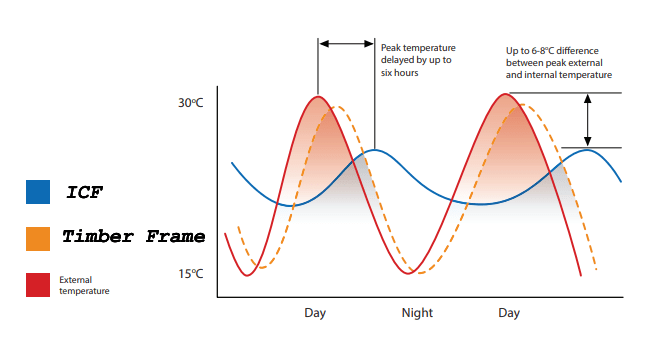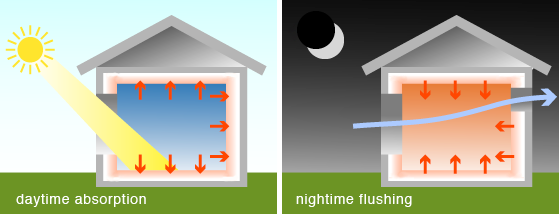Home Energy Model
The UK is updating how it measures new home energy performance. The Home Energy Model (HEM) is being introduced to replace the current Standard Assessment Procedure (SAP).
It is generally accepted that SAP is a simple and outdated system as it was initially designed for an on-site assessor who only had basic tools to hand. Despite many revisions, the principles remain the same and do not accurately reflect how heating systems perform in the building envelope which they heat and cool.
This is particularly problematic given the UK government push to replace gas boilers with heat pumps. Indeed, high thermal mass significantly enhances the overall system efficiency and comfort provided by a heat pump, but it is virtually ignored in the current SAP assessments. Hence, SAP needs to be revised so that it is based on rational logic that takes into account the benefits provided by the Thermal Mass of buildings.
How will the Home Energy Model differ from SAP?
Key Metrics
Before June 2022 SAP focused on two key metrics: the Dwelling Emission Rate (DER) and the Dwelling Fabric Energy Efficiency (DFEE). Both of these will carry over into the new Home Energy Model (HEM) as well as the recently included element: the Dwelling Primary Energy Rate (DPER introduced in June 2022). This addition provides a more comprehensive picture of a home’s energy consumption by considering the total primary energy used at the source (like a power station), not just what’s consumed at the meter.
SAP calculations establish Target Emissions Rates (TER), Target Fabric Energy Efficiency (TFEE) and Target Primary Energy Rates (TPER). These targets are based on a “notional building” – a hypothetical structure with the same dimensions as the actual building but incorporating the U-value requirements of the Building Regulations. For a property to comply, its DER and DFEE must be lower than these respective TER and TFEE targets. It’s worth noting that in Wales, Northern Ireland, and Scotland, only the DER must be lower than the TER; the DFEE < TFEE rule doesn’t apply.
Hypothetical structure which specifies U-values, air permeability, heating systems, and other parameters that set the bar for performance.
Derived from a “notional dwelling” of the same type, size, and shape as the proposed dwelling, but insulated to meet the minimum efficiency standards set out in the Building Regulations (Part L, specifically L1A for new dwellings).
The calculated actual CO2 emissions of the “proposed dwelling” based on its specific design, materials, heating system, renewables, etc.
This is the calculated actual energy demand for space heating and cooling of the proposed dwelling’s fabric.
Key metric used to assess the proposed dwelling’s energy efficiency.
L1A & L1B
SAP calculations come in two formats; L1A (new builds) and L1B (extensions and conversions). Their primary purpose is to produce a new or updated Energy Performance Certificate (EPC). This will be continued in the Home Energy Model (HEM) which is being set up so that it can work with different software applications that will use the HEM as the basic calculation engine.
In England, under the Future Homes Standard (FHS) which the Home Energy Model (HEM) is designed to assess, the fundamental compliance metrics will not be changed:
DPER
The Home Energy Model will also use the third metric, DPER that must be less than or equal to the TPER. TPER is the Target Primary Energy Rate based on the notional building and the most efficient energy source such as a heat pump with waste heat recovery. The TPER will incorporate the same PEF as the DPER. Whilst they both assess primary energy use, Home Energy Model calculations are made every 30 minutes compared to once a month in SAP.
DFEE identifies the total heat lost through the building fabric and DPER identifies the total energy required after taking account of the efficiency of the heating system, the use of renewables and a Primary Energy Factor (PEF) applied to the gas or electricity that is supplied to the dwelling.
DPER is the Dwelling Primary Energy Rate based on the proposed dwelling including the heating and cooling systems. It involves calculating the total forecast energy demand of the dwelling using PEF factors identified in the Building Regs. The projected annual demand will be divided by the building area to obtain a figure in kWh/m2 per year.
Energy from PV cells will reduce the amount supplied from the grid that will supply electricity with a PEF of say 1.5 that will increase the DPER.
Reports
This is still under consultation but it is very likely that two reports will be required as is currently the case with SAP:
Home Energy Model Differentiates Between New Builds & Extensions
Part L
The Home Energy Model is primarily being developed to underpin the Future Homes Standard for new dwellings but will also be applied to extensions, material alterations, and change of use to existing dwellings.
Separate Regulatory Requirements (Part L): In the UK Building Regulations, Part L (Conservation of Fuel and Power) has historically had different requirements for new dwellings versus work to existing dwellings.
While the numbering and structure will evolve with the Future Homes Standard, the fundamental principle of having different performance targets and compliance pathways for new builds versus extensions will remain. This is because it is generally much harder and more expensive to achieve the same levels of fabric performance in an extension to an existing building as it is in a brand-new, purpose-designed structure.
Compliance Pathways
For extensions, the compliance methodology typically involves ensuring the new elements of the extension (walls, roof, floor, windows, doors) meet specific limiting U-values and design criteria.
There are often different ways to demonstrate compliance for extensions:
“Wrappers”
The Home Energy Model is being designed with a modular structure, including “Core Calculations” and “Wrapper Components.” This allows the core simulation engine to be applied to different policy uses. It’s expected that there will be different “wrappers” or methodologies within HEM to cater specifically for:
Benefits of ICF with Mandatory HEM Use
ICF Overcomes ALL Disadvantages
ICF construction inherently addresses the very challenges that low-mass timber frame and externally-insulated cavity walls face with dynamic thermal modeling and heat pump synergy.
In essence, ICF construction directly provides the “fabric first” benefits that the Home Energy Model is designed to accurately measure and that heat pumps thrive on:
Therefore, as the Home Energy Model becomes the standard for compliance, ICF dwellings are very well-positioned to demonstrate superior energy performance. Achieving excellent DER, DFEE, DPER ratings and provide an optimal environment for highly efficient heat pump operation. Especially compared to their timber frame or conventional cavity wall counterparts.
Find out more about the sustainability of ICF, Timber Frame and Cavity Wall construction techniques:
The dramatic reduction in energy costs and the additional comfort levels in summer and winter that are provided by a home built in ICF are not identified in the SAP process but they will be in the Home Energy Model.


Build smarter: stay up to date with the latest industry news & icf insights
Subscribe to our newsletter for exclusive Insulated Concrete Formwork construction insights, key industry developments and updates on the constantly evolving landscape of house building in the UK.